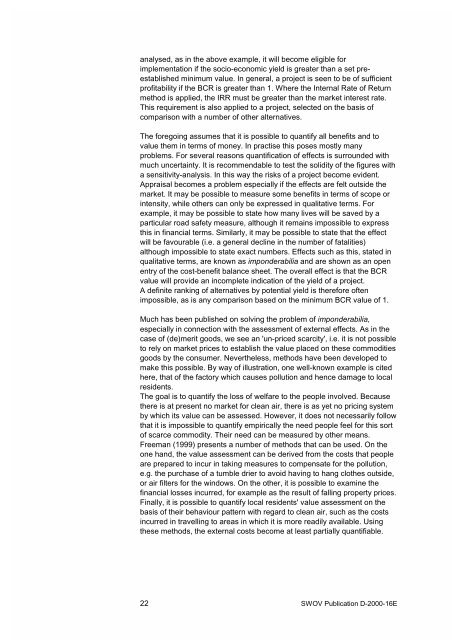Economic evaluation of road safety measures - Swov
Economic evaluation of road safety measures - Swov
Economic evaluation of road safety measures - Swov
You also want an ePaper? Increase the reach of your titles
YUMPU automatically turns print PDFs into web optimized ePapers that Google loves.
analysed, as in the above example, it will become eligible for<br />
implementation if the socio-economic yield is greater than a set preestablished<br />
minimum value. In general, a project is seen to be <strong>of</strong> sufficient<br />
pr<strong>of</strong>itability if the BCR is greater than 1. Where the Internal Rate <strong>of</strong> Return<br />
method is applied, the IRR must be greater than the market interest rate.<br />
This requirement is also applied to a project, selected on the basis <strong>of</strong><br />
comparison with a number <strong>of</strong> other alternatives.<br />
The foregoing assumes that it is possible to quantify all benefits and to<br />
value them in terms <strong>of</strong> money. In practise this poses mostly many<br />
problems. For several reasons quantification <strong>of</strong> effects is surrounded with<br />
much uncertainty. It is recommendable to test the solidity <strong>of</strong> the figures with<br />
a sensitivity-analysis. In this way the risks <strong>of</strong> a project become evident.<br />
Appraisal becomes a problem especially if the effects are felt outside the<br />
market. It may be possible to measure some benefits in terms <strong>of</strong> scope or<br />
intensity, while others can only be expressed in qualitative terms. For<br />
example, it may be possible to state how many lives will be saved by a<br />
particular <strong>road</strong> <strong>safety</strong> measure, although it remains impossible to express<br />
this in financial terms. Similarly, it may be possible to state that the effect<br />
will be favourable (i.e. a general decline in the number <strong>of</strong> fatalities)<br />
although impossible to state exact numbers. Effects such as this, stated in<br />
qualitative terms, are known as imponderabilia and are shown as an open<br />
entry <strong>of</strong> the cost-benefit balance sheet. The overall effect is that the BCR<br />
value will provide an incomplete indication <strong>of</strong> the yield <strong>of</strong> a project.<br />
A definite ranking <strong>of</strong> alternatives by potential yield is therefore <strong>of</strong>ten<br />
impossible, as is any comparison based on the minimum BCR value <strong>of</strong> 1.<br />
Much has been published on solving the problem <strong>of</strong> imponderabilia,<br />
especially in connection with the assessment <strong>of</strong> external effects. As in the<br />
case <strong>of</strong> (de)merit goods, we see an 'un-priced scarcity', i.e. it is not possible<br />
to rely on market prices to establish the value placed on these commodities<br />
goods by the consumer. Nevertheless, methods have been developed to<br />
make this possible. By way <strong>of</strong> illustration, one well-known example is cited<br />
here, that <strong>of</strong> the factory which causes pollution and hence damage to local<br />
residents.<br />
The goal is to quantify the loss <strong>of</strong> welfare to the people involved. Because<br />
there is at present no market for clean air, there is as yet no pricing system<br />
by which its value can be assessed. However, it does not necessarily follow<br />
that it is impossible to quantify empirically the need people feel for this sort<br />
<strong>of</strong> scarce commodity. Their need can be measured by other means.<br />
Freeman (1999) presents a number <strong>of</strong> methods that can be used. On the<br />
one hand, the value assessment can be derived from the costs that people<br />
are prepared to incur in taking <strong>measures</strong> to compensate for the pollution,<br />
e.g. the purchase <strong>of</strong> a tumble drier to avoid having to hang clothes outside,<br />
or air filters for the windows. On the other, it is possible to examine the<br />
financial losses incurred, for example as the result <strong>of</strong> falling property prices.<br />
Finally, it is possible to quantify local residents' value assessment on the<br />
basis <strong>of</strong> their behaviour pattern with regard to clean air, such as the costs<br />
incurred in travelling to areas in which it is more readily available. Using<br />
these methods, the external costs become at least partially quantifiable.<br />
22 SWOV Publication D-2000-16E
















